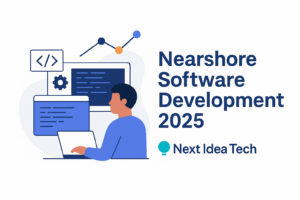
Generative AI promises to rewrite the way software is built and maintained and technology leaders have already expressed a strong interest in using Gen AI to improve developer productivity and accelerate software development. Software engineering leaders are exploring Gen AI technologies, especially AI coding assistants to augment coding and testing activities. By building on patterns they find in existing open-source code they find on the internet and on a corporation’s proprietary codebase, generative artificial intelligence (AI) platforms like Gemini Code Assist, IBM watsonx Code Assistant, GitHub Copilot, and Amazon Q Developer can generate original code.
Hire the best developers in Latin America. Get a free quote today!
Contact Us Today!With the right upskilling and enterprise enablers, this emerging/nascent type of artificial intelligence promises groundbreaking speed gains for many common developer tasks like writing new code, optimizing existing code (refactoring), debugging, automating testing and QA, generating documentation for code functionality, among other low hanging fruit use cases. For many developers, generative AI will become the most valuable coding partner they will ever know. It will allow them to hand off the repetitive parts of their jobs, supercharging their productivity and accelerating the time to deployment for new software.
But before we get into how generative AI can enhance engineering productivity and developer experience, let’s look more generally into what makes a developer productive and how to measure productivity.
What Makes a Developer Productive?
A productive developer has strong problem-solving skills, an efficient workflow, effective time management expertise, and a continuous learning mindset. A productive developer is also always looking for ways to minimize cognitive overhead and time spent on repetitive tasks, and readily adopts new tools to aid in this pursuit.
Developer productivity can easily be measured in terms of tasks completed, number of bugs fixed, number of lines written, or number of hours clocked in. However, these are not always accurate measurements since developer productivity extends beyond mere code generation; consider how the developer’s contributions impact project milestones, business objectives, and user satisfaction — while mitigating the risk of burnout.
Therefore, an efficient developer is one who always seeks out ways to streamline their workflow and implements tools that can simplify tasks and enhance productivity like generative AI.
How Developers are Using Generative AI Models to Boost Productivity
There are several ways that Generative AI can augment developer activities and streamline development workflows. Here are some of the most common use cases:
1. Explaining the functionality of code
Generative AI can be used to generate text summaries of code that help developers quickly understand what a particular block of code does. Developers can therefore leverage large language models designed for code to explain the functionality of code they did not write but are now tasked with maintaining or upgrading. This can lower the barriers to entry for new developers on complex codebases, allowing companies to do things that were previously impossible, such as:
Rapidly onboarding new developers to accelerate new features or major software changes. These developers would be productive quickly and require less guidance from existing developers.
Using nearshore resources more effectively. A contextually informed generative AI assistant could provide guidance to a nearshore software development team while senior onshore engineers and product owners focus on other activities. This also may enable changes to the resource mix to take greater advantage of nearshore resources.
2. Eliminating repetitive tasks
Programming often involves simple, sometimes tedious tasks. Developers derive satisfaction from GenAI tools because they remove the pain associated with unpleasant and repetitive tasks—tasks like setting up boilerplates, refactoring, and correctly structuring API requests. AI programming assistants like Amazin Q can expedite this process by suggesting lines of code or entire functions based on natural language descriptions. Unlike a human, Gen AI platforms never get tired or annoyed about performing simple, repetitive tasks.
Generative AI is also useful for tasks that take a long time to complete manually, but can be quickly checked for completeness and accuracy (think: converting data from one file format to another).
3. Code suggestion
Solving an unfamiliar problem can lead to a significant loss of momentum. This is especially noticeable when working on projects involving frameworks or APIs that are new to a developer due to the additional cognitive overhead required to figure out how to even approach finding a solution. Generative AI can act as an expert coworker or coding partner that provides context-aware suggestions, explanations, and guidance as you write code.
4. Reducing cognitive fatigue
Cognitive fatigue has a powerful negative influence on decision-making and therefore on productivity, quality, and innovation. A leading cause of cognitive fatigue for developers is context switching, which happens when developers are interrupted or switch to a different task because their current task is blocked. Developers who do not have to switch contexts describe entering a “flow state” in which they are highly productive.
Generative AI can help minimize or even eliminate the back-and-forth context switching for developers.
5. Research assistance
Using Generative AI to research can help developers brainstorm potential solutions to problems they’re facing much quicker compared to performing Google searches. When used to their full potential, large language models can reduce research time down to near zero thanks to their massive context window. While humans are only capable of holding a few elements in our context window at once, Gen AI models can handle an ever-increasing number of source files and documents. The difference can be described in terms of reading a book: As humans, we’re only able to see two pages at a time—this would be the extent of our context window; but an LLM can see every page in a book simultaneously. This has profound implications for how developers analyze data and conduct research.
GPT-4 now supports over 100,000 words while Gemini has the capacity for up to one million words. With earlier versions of these tools you could only give them the section of code you were working on as context; nowadays it’s now possible to provide the README file of the project along with the full source code as context in the window before asking your questions.
6. Improving the consistency of code
Generative AI can improve the consistency of code by identifying redundant or inefficient portions and suggesting improvements. Problems that may have been tricky to pinpoint can be found and rectified much more quickly by implementing AI-suggested solutions such as automated refactoring, style changes and automatically generating explanatory comments. This can aid in maintaining code quality and performance over time.
7. Automating testing and QA
QA teams spend a lot of time writing test cases for complex scenarios involving the product logic. Generative AI can be employed in creating test cases automatically. Deep learning models can analyze large code bases at a fast pace and with improved accuracy than is humanly possible. These AI-powered testing tools can function like an assistant contributing to the code review process, helping to improve test coverage, identifying potential issues early in the development process, and resolving corner-case errors that occur outside normal operating parameters.
8. Accelerating debugging
By analyzing large codebases at scale, generative AI can assist software development teams in identifying and even automatically fixing bugs. This can lead to more robust and reliable software, as well as faster development cycles.
9. Translating code from one language to another
Generative AI can also translate code from one language to another, streamlining code conversion. This can make developers more fungible across frameworks, platforms, and data management systems. Generative AI will provide the scaffolding and guidance they need to work on a wider range of projects than they would normally be able to handle.
Developers and IT Operators can also use this capability to speed up application modernization efforts such as updating legacy applications by transforming Visual Basic to Java as more of that legacy knowledge is built into a fine-tuned generative model. An existing fine-tuned generative AI model would also improve the quality of technical due diligence during the acquisition of software-related intellectual property.
10. Writing documentation
Generative AI can assist engineering teams in generating documentation by summarizing code functionalities, explaining algorithms and providing context. This can be useful for maintaining clear and up-to-date project documentation.
11. Improving collaboration and communication
GenAI promises to make the collaboration between the software engineering team and nontechnical stakeholders more effective. Generative AI tools that help improve written communication, such as GrammarlyGO and built-in grammar tools in Google Workspace, are already established.
Software engineering teams are already applying these advances. For example, they are using GenAI tools to help write user stories and create documentation from source code. Developer productivity is improved through reduced effort and higher efficiency; but more importantly, the tools can enable more effective communication.
For example, translations can be made faster and more accurate, so that multinational team members can work together with less miscommunication. Another example would be a developer who may find it unpleasant or difficult to communicate complex concepts in complete sentences. Newer large language models like GPT-4 can handle real-time interactions and turn sentence fragments into clear and coherent sentences that communicate ideas more concisely.
Limitations of Gen AI Tools for Increasing Developer Productivity
For all of their sophistication, current iterations of generative AI can still generate flawed results and therefore software engineering leaders must implement safety controls that ensure humans remain in the loop when using GenAI tools. GenAI tools are known to produce “sophisticated errors.” These are errors that are especially difficult to detect because, through the process of prompting and re-prompting, the tool has produced code that seems to satisfy the developer’s intent. In other words, the code appears to work perfectly. It is only by carefully examining the code and testing for exceptional cases that sophisticated errors can be found.
In most cases it wouldn’t be wise to copy and paste AI-generated code wholesale and expect it to run properly—even when there are no hallucinations, there are almost always lines that need to be tweaked because AI lacks the full context of the project and its objectives.
Developers who want to make the most of generative AI for coding should not give it too much responsibility all at once. These tools work best when given clearly scoped problems that follow predictable patterns. Anything more complex or open-ended just invites hallucinations.
To limit hallucinations when faced with any important task where small mistakes are unacceptable, you should always cross-reference the AI output against search engine results and trusted resources.
How Next Idea Tech Can Help
The maturity of adoption and use of Generative AI tools that boost developer productivity is still understandably low. Vendors and users alike are just beginning to use these tools to enhance their processes. Despite the challenges posed by generative AI, the long term upside still remains extremely positive and we believe any large organization with a lot of developers that isn’t urgently exploring the opportunity is doing its stakeholders a disservice.
As an early adopter of artificial intelligence, Next Idea Tech is positioned to help your organization leverage generative AI to transform software development and give you a leg up on your competitors. Drawing on our deep expertise in custom software development, we can guide your organization through strategy development, platform selection and implementation—and then provide ongoing support to help you optimize your investment in this transformative technology.
Ready to transform your tech talent strategy? Explore how Next Idea Tech can help your organization achieve results and boost developer productivity.
Schedule a consultation with our team to learn more about how Next Idea Tech can drive value for your organization.




